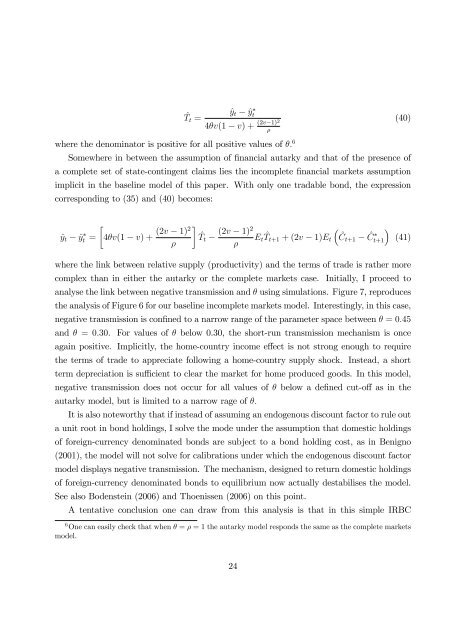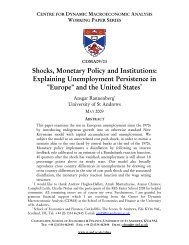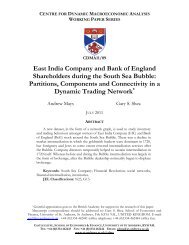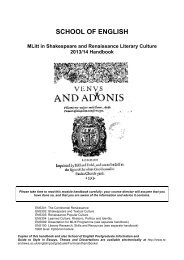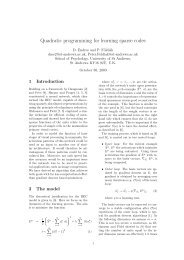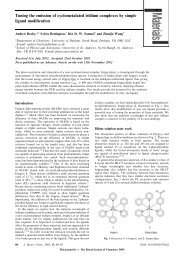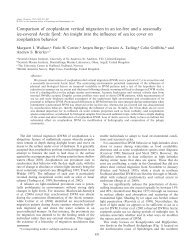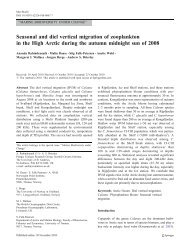Exchange rate dynamics, asset market structure and the role of the ...
Exchange rate dynamics, asset market structure and the role of the ...
Exchange rate dynamics, asset market structure and the role of the ...
Create successful ePaper yourself
Turn your PDF publications into a flip-book with our unique Google optimized e-Paper software.
^y t ^y t<br />
^T t =<br />
4v(1 v) +<br />
(2v 1)2<br />
<br />
where <strong>the</strong> denominator is positive for all positive values <strong>of</strong> : 6<br />
Somewhere in between <strong>the</strong> assumption <strong>of</strong> …nancial autarky <strong>and</strong> that <strong>of</strong> <strong>the</strong> presence <strong>of</strong><br />
a complete set <strong>of</strong> state-contingent claims lies <strong>the</strong> incomplete …nancial <strong>market</strong>s assumption<br />
implicit in <strong>the</strong> baseline model <strong>of</strong> this paper. With only one tradable bond, <strong>the</strong> expression<br />
corresponding to (35) <strong>and</strong> (40) becomes:<br />
(40)<br />
^y t ^y t =<br />
4v(1 v) +<br />
<br />
(2v 1)2<br />
<br />
(2v 1)<br />
^T 2<br />
<br />
t E t ^Tt+1 + (2v 1)E t ^Ct+1 ^C<br />
<br />
t+1<br />
(41)<br />
where <strong>the</strong> link between relative supply (productivity) <strong>and</strong> <strong>the</strong> terms <strong>of</strong> trade is ra<strong>the</strong>r more<br />
complex than in ei<strong>the</strong>r <strong>the</strong> autarky or <strong>the</strong> complete <strong>market</strong>s case. Initially, I proceed to<br />
analyse <strong>the</strong> link between negative transmission <strong>and</strong> using simulations. Figure 7, reproduces<br />
<strong>the</strong> analysis <strong>of</strong> Figure 6 for our baseline incomplete <strong>market</strong>s model. Interestingly, in this case,<br />
negative transmission is con…ned to a narrow range <strong>of</strong> <strong>the</strong> parameter space between = 0:45<br />
<strong>and</strong> = 0:30. For values <strong>of</strong> below 0.30, <strong>the</strong> short-run transmission mechanism is once<br />
again positive. Implicitly, <strong>the</strong> home-country income e¤ect is not strong enough to require<br />
<strong>the</strong> terms <strong>of</strong> trade to appreciate following a home-country supply shock. Instead, a short<br />
term depreciation is su¢ cient to clear <strong>the</strong> <strong>market</strong> for home produced goods. In this model,<br />
negative transmission does not occur for all values <strong>of</strong> below a de…ned cut-o¤ as in <strong>the</strong><br />
autarky model, but is limited to a narrow rage <strong>of</strong> :<br />
It is also noteworthy that if instead <strong>of</strong> assuming an endogenous discount factor to rule out<br />
a unit root in bond holdings, I solve <strong>the</strong> mode under <strong>the</strong> assumption that domestic holdings<br />
<strong>of</strong> foreign-currency denominated bonds are subject to a bond holding cost, as in Benigno<br />
(2001), <strong>the</strong> model will not solve for calibrations under which <strong>the</strong> endogenous discount factor<br />
model displays negative transmission. The mechanism, designed to return domestic holdings<br />
<strong>of</strong> foreign-currency denominated bonds to equilibrium now actually destabilises <strong>the</strong> model.<br />
See also Bodenstein (2006) <strong>and</strong> Thoenissen (2006) on this point.<br />
A tentative conclusion one can draw from this analysis is that in this simple IRBC<br />
6 One can easily check that when = = 1 <strong>the</strong> autarky model responds <strong>the</strong> same as <strong>the</strong> complete <strong>market</strong>s<br />
model.<br />
24


